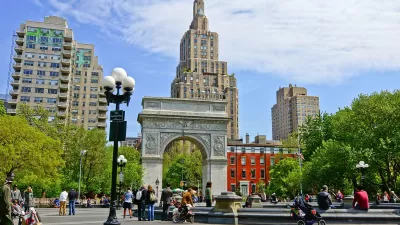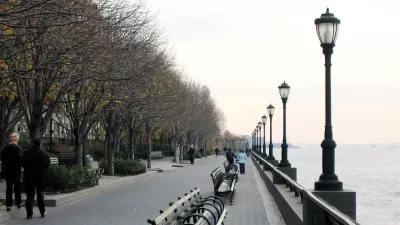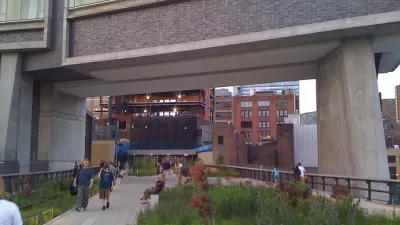Managing Editor Tim Halbur reviews The High Line, the much-lauded new linear park in Manhattan.
The High Line opened a few weeks ago to rapturous reviews and a surfeit of coverage. The story is irresistible - how a ragtag community group came together to promote the idea of turning an abandoned stretch of elevated railway into a public park, and the city listened! A public-private partnership resulted: money was raised, miles of red tape were cut, and a most unusual park rose out of the Meatpacking District.
With so much written (and filmed- see 1, 2, and 3), I thought it best to step out of the picture and let The High Line speak for itself. Here's a portrait of the park on a sunny weekend in June:
A Walk On The High Line from Urban Insight on Vimeo.
To me, the most remarkable aspect of the park is the way it redefines a number of stubbornly persistent beliefs in what a park should be. Firstly, of course, is the anti-urban idea that parks should recreate the wilderness. While the design incorporates the natural growths that sprung up on the site after its closing in 1980, the landscaping is sculpted and controlled. It also doesn't attempt to mask the urban scene: the views are paramount, from the sleek new contemporary building that straddles the park to the myriad brick and mortar buildings that surround it. The rusted railroad tracks of the past add a pleasant wabi sabi to the design.
The second myth of parks that The High Line easily dismisses is that parks have to be multi-use. Unlike the unloved 'open space' lots of the past, The High Line is not set up for soccer, barbeques, or kids gymnastics. A wide, uneven cement path winds through the landscape, a design that begs to be perambulated at a slower pace. It is more like a European boulevard than an American park. Sitting is also greatly encouraged -- understated benches are plentiful, and the loungers are wide and inviting.

Finally, the modernist design and clean lines of the park feel like a vindication for the Dwell crowd. Public spaces across the country were marred by poor urbanism inflicted by modernists, but the subdued benches, slatted concrete, and glass and steel fences of The High Line all come together into a harmonious experience that traditional design would not have accomplished.
Much of the credit goes to James Corner Field Operations, the landscape architects. As James Corner, lead designer, said in an interview, "How do you keep that quality, this magical, found landscape in the city, and at the same time allow hundreds of people up there to walk, to stroll, to sit, and stand and enjoy views?" That is exactly what they've pulled off with The High Line.
A caveat: years ago when I was writing my masters' project on the problems of United Nations Plaza in San Francisco, I went to New York to find other public spaces to offer as comparisons. In the end, I had to conclude that New York's public parks and plazas are not comparable -- the constant flow of people in, around, and through the public spaces can be found nowhere else in this nation. Attempts to create elevated or sunken plazas in other cities have backfired, either sucking the life out of the surroundings or stagnating from disuse.
So for cities considering replicating the success of The High Line, a word of warning: don't try this at home.

Alabama: Trump Terminates Settlements for Black Communities Harmed By Raw Sewage
Trump deemed the landmark civil rights agreement “illegal DEI and environmental justice policy.”

Planetizen Federal Action Tracker
A weekly monitor of how Trump’s orders and actions are impacting planners and planning in America.

Why Should We Subsidize Public Transportation?
Many public transit agencies face financial stress due to rising costs, declining fare revenue, and declining subsidies. Transit advocates must provide a strong business case for increasing public transit funding.

Understanding Road Diets
An explainer from Momentum highlights the advantages of reducing vehicle lanes in favor of more bike, transit, and pedestrian infrastructure.

New California Law Regulates Warehouse Pollution
A new law tightens building and emissions regulations for large distribution warehouses to mitigate air pollution and traffic in surrounding communities.

Phoenix Announces Opening Date for Light Rail Extension
The South Central extension will connect South Phoenix to downtown and other major hubs starting on June 7.
Urban Design for Planners 1: Software Tools
This six-course series explores essential urban design concepts using open source software and equips planners with the tools they need to participate fully in the urban design process.
Planning for Universal Design
Learn the tools for implementing Universal Design in planning regulations.
Caltrans
Smith Gee Studio
Institute for Housing and Urban Development Studies (IHS)
City of Grandview
Harvard GSD Executive Education
Toledo-Lucas County Plan Commissions
Salt Lake City
NYU Wagner Graduate School of Public Service





























